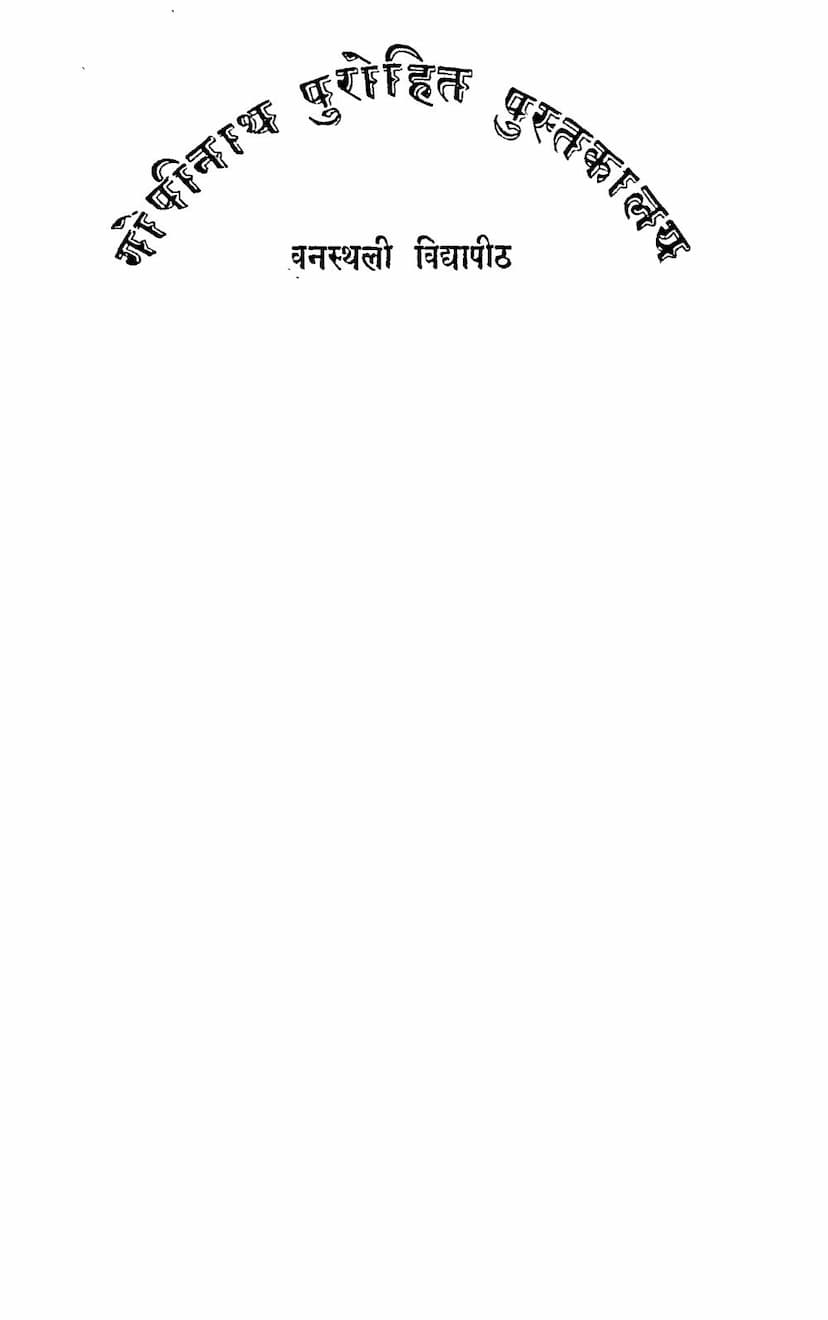Kavyanushasanam Satikam
Added to library: September 2, 2025

Summary
This is a summary of the provided Jain text, "Kavyanushasanam Satikam" by Kashinath Sharma, based on the catalog link and the scanned pages.
Book Title: Kavyanushasanam Satikam Author: Hemachandra (original text), Kashinath Sharma (editor/publisher) Publisher: Kashinath Sharma (for this edition), Nirnaya Sagar Press (printer) Year of Publication: 1901
Overview:
Kavyanushasanam Satikam is a commentary (Tika) on the Kavyanushasanam, a seminal work on Sanskrit poetics (Alankara Shastra) authored by the renowned Jain acharya Hemachandra. This specific edition was revised and published by Kashinath Sharma, printed at the Nirnaya Sagar Press in Bombay in 1901. The text is a comprehensive guide to the principles and practices of Sanskrit poetry, covering its definition, causes, types, characteristics, and various figures of speech (Alankaras).
Key Aspects and Content:
The provided text appears to be the introductory and early sections of the commentary by Hemachandra himself, possibly titled "Alankarachudamani," as indicated on page 14. The initial pages (1-13) focus on the author Hemachandra, his background, lineage, and the historical context of his works, particularly in relation to King Kumarapala of Gujarat. This section establishes Hemachandra as a highly influential Jain scholar and poet of the 12th century CE.
The subsequent pages delve into the Kavyanushasanam and its commentary:
-
Introduction to Poetry (Kavya): The text begins with an invocation to Jaina Tirthankaras and defines poetry as a unique art form that provides delight, fame, and instruction, comparable to a beloved. It emphasizes the role of "Pratibha" (poetic genius or imagination) as the primary cause of poetry, supported by learning (Vyutpatti) and practice (Abhyasa).
-
Definition and Causes of Poetry: The commentary meticulously explains that poetry is distinct from other forms of literature like Shastra (treatises) and Akhyana (narratives). It highlights the importance of "Rasa" (aesthetic sentiment) as the core element that distinguishes poetry, with an emphasis on the delight (Ananda) it provides to both the poet and the audience (Sahṛdaya).
-
Classification of Words and Meanings: Hemachandra classifies words based on their intended meanings: Mukhya (primary), Gauṇa (secondary/metaphorical), Lakṣya (indicated), and Vyaṅgya (suggested/implied), with detailed explanations of each. This establishes the foundation for understanding various figures of speech.
-
Figures of Speech (Alankaras): The bulk of the text is dedicated to explaining and illustrating various figures of speech. These are categorized into:
- Sabdālankāras (Figures of Sound): Primarily focusing on Anuprāsa (alliteration), where the repetition of sounds creates a pleasing effect. The text details various types of Anuprāsa.
- Arthalankāras (Figures of Meaning): This is a major section, covering a wide range of figures of speech, including:
- Upama (Simile): Comparing two things based on shared qualities, with detailed explanations of its parts and variations like Lupta Upama (omitted simile), Malopama (garland simile), etc.
- Rupaka (Metaphor): The identification of one thing with another.
- Atishayokti (Hyperbole): Exaggeration for effect.
- Vyanjana (Suggestion/Implication): The subtle conveyance of meaning beyond the literal.
- Shlesh (Pun): The use of a word with multiple meanings.
- Vakrokti (Indirect speech/Oblique statement): Conveying meaning indirectly.
- Nidarshana (Illustration): Using an example to explain a concept.
- Parinamā (Transformation): A figure where one thing is described as having transformed into another.
- Parivṛtti (Exchange): The exchange of qualities or roles.
- Anumana (Inference): Inferring one thing from another.
- Smṛti (Remembrance): Recalling past associations.
- Bhranti (Delusion/Misapprehension): Mistaking one thing for another.
- Vishama (Incongruity): The incongruous presentation of a situation.
- Samam (Equanimity): The state of being balanced or equal.
- Sanyog (Conjunction): The coming together of things.
- Viyog (Separation): The parting of things.
- Sahacharyam (Companionship): The association of things.
- Virodhita (Opposition): The state of being opposite.
- Arthaha (Meaning): The inherent meaning.
- Prakaranam (Context): The surrounding circumstances.
- Lingam (Sign/Indication): An indicator.
- Shabdaha (Word): The sound itself.
- Anyasanydhi (Proximity to others): The influence of other factors.
- Samarthyam (Capability): The inherent power.
- Auchityam (Propriety): The suitability of expression.
- Desh (Place): The setting.
- Kalah (Time): The temporal context.
- Vyakti (Person): The speaker or subject.
- Svaraha (Tone): The pitch and modulation.
- Adigrahanat (And others): Mentioning other elements like gestures and indications.
- Vajra-Vichitra Bandha: Complex metrical arrangements.
-
Classification of Rasa (Aesthetic Sentiments): The text elaborates on the nine primary Rasas: Shṛṅgāra (Erotic), Hāsya (Humorous), Karuṇa (Pathos), Raudra (Terrible/Wrathful), Vīra (Heroic), Bhayānaka (Fearful), Vībhatsa (Disgusting), Adbhuta (Wondrous), and Śānta (Peaceful). It explains how these are evoked through Vibhāvas (stimuli), Anubhāvas (expressions), and Vyabhicārī Bhāvas (transitory emotions).
-
Classification of Characters (Nayaka and Nayika): The text details the characteristics and types of heroes (Nayaka) and heroines (Nayika), including classifications based on their nature (Dhīrodātta, Dhīralalita, Dhīraśānta, Dhīroddhata), their disposition towards their beloved (Dakṣiṇa, Śaṭha, Anukūla), and the stages of love and emotion they experience.
-
Types of Plays (Rupakas): The text outlines various dramatic forms like Nāṭaka, Prakaraṇa, Nāṭikā, Samavakāra, Īhāmṛga, Vyāyoga, Utsṛṣṭikāṅka, Prahasana, Bhāṇa, Vīthī, and Saṭṭaka, briefly mentioning their defining characteristics.
-
Critique of Poetic Flaws (Doshas): A significant portion is dedicated to identifying and explaining various flaws in poetry (Kavya Doshas) related to words (Sabda Doshas) and meanings (Artha Doshas). These include grammatical errors, semantic inconsistencies, awkward phrasing, and inappropriate expressions.
Significance:
Hemachandra's Kavyanushasanam is a cornerstone of Sanskrit literary criticism, renowned for its systematic approach, clarity, and wealth of examples. The commentary by Hemachandra himself adds immense value, providing deeper insights into the nuances of poetic theory. Kashinath Sharma's 1901 edition makes this important work accessible to a wider audience, contributing to the study and appreciation of classical Indian literature and poetics.
This edition highlights the meticulous work of its editors and publishers in preserving and disseminating classical Sanskrit knowledge, particularly within the Jain scholarly tradition.